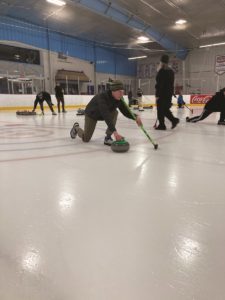ORLEANS — Curling always mystified Ron Fancy. And so, he took up the sport.
He had watched curling on TV, Fancy said, but “I just couldn’t understand how they did it.” Five years later, the Lower Cape Curling Club (LCCC) founder is starting to “figure out the ice.”
After watching Olympians curl on television last month, two of us Indie reporters wanted to know more. Curling — a sport invented in Scotland and adopted big time by Canadians — is surprisingly popular in the U.S., with 185 amateur curling clubs across the country, according to USA Curling.
Finding a club right here on the Cape, we went to the Charles Moore Arena in Orleans on Feb. 20 for a Sunday night practice with Fancy.
Fancy is fully invested in the curling program. He’s the equipment manager and initially paid out of pocket for the curling gear: stones (granite disks), hacks, and an $1,800 nipper. Curling has its own odd vocabulary.
About 25 local sponsors have since chipped in, and their support has covered the $250-per-stone cost of the 40-some stones needed by the club, said Fancy. In return, the sponsors’ names appear on those stones.
Fancy worked with Charles Moore’s rink managers to start the club in 2018 with help from Chatham resident Evelyn Nostrand, a former president of the U.S. Curling Association. The Independent first wrote about the club in 2019. Since then, the world has changed, but the club hasn’t. Shanna Nealy, LCCC’s press manager, said the pandemic forced them to shut down for a few months during 2020, but when the rink was open again curlers picked up right where they left off.
Some new members have also joined, perhaps inspired by watching the winter Olympics. In Beijing, Italy took the gold medal for the mixed doubles competition; Sweden’s men’s team and Great Britain’s women’s team also won gold. The U.S. Olympic curling team has medaled only twice since the Olympics introduced the sport at the 1998 Nagano games. Perhaps they’ve been waiting for two young lads on Cape Cod to take the ice.
Olympic ambitions aside, for those who enjoy the camaraderie of community curling, the club occasionally hosts “Learn to Curl” events and holds regular practices on Wednesday mornings and Sunday nights.
That’s where we were, along with 25 others, ready to curl. But before we could figure out our own ice, we suited up.

There isn’t much to the uniform. Most curlers donned LCCC hats and windbreakers, in addition to the rubber shoe grips we pried on with Fancy’s help. With frictioned soles attached and brooms in hand, we walked onto the rink.
On the ice, players deliver the stone from the “hack” — a launching platform that looks like a sprinter’s starting block — and players then sweep the ice in front of the stone, allowing the disk to travel farther. Curlers aim to deliver their stones into a target area, or bullseye, called the “house.” The “nipper” uses three blades to “nip” the tops of uneven pebbles of ice, creating a smooth path for stones.
Readers might be relieved to know that Fancy simply calls his curling shoes “curling shoes,” and the 20-foot-long precision ruler that can measure the stone’s position to one one-hundredth of an inch is humbly called a “measuring device.”
Fancy is still learning the intricacies of curling, and he wasn’t shy about some of the aspects of the game that continue to confuse him.
“Can a curler’s sweeping actions adjust the direction of a stone?” one of us asked.
“I don’t know,” he responded, “but you always need a Plan B.”
Fancy, who also helps coach the Nauset High boys soccer team, explained curling using other sports: “It’s scored like bocce,” he said. “The delivery is like golf. And the strategy is like chess.” But before we could get lost in the metaphors, shouts of “Sweep!” filled the air and gave an urgency to the sport we hadn’t expected.
Also unexpected was the physicality of the sport. It’s a workout.
Curlers glide out in a lunge position, one hand on the stone and the other applying pressure to the broom, locked between shoulder and ice. An hour in, Thomas had already fallen twice, a wobbling posture threatening to upend his lead. Ryan had a somewhat more graceful delivery (though let the record show he also fell) and was consistently able to arc his stones inside the bullseye.
Fancy explained that the ice slopes upward at the rink’s edges, so we thought about how to navigate that pitch as we crouched atop the hack, considering our pre-delivery strategy.
We didn’t keep score. We swept for one another’s deliveries, mutually working to improving our curling capabilities. Will you see us at the 2026 Winter Olympics? Maybe.
But we’ll be sure to have a Plan B.
